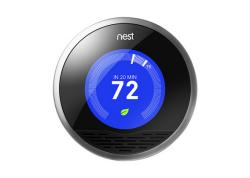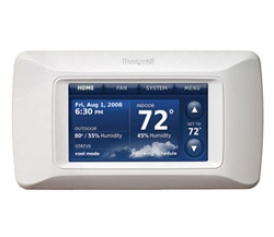The Thermostat Wars
How Honeywell could beat popular upstart Nest.

One morning last fall, Pat Tessier, a marketing director at the electronics giant Honeywell, stopped by my house to show me the company’s high-end thermostat, the Prestige HD. It was an unusual visit. Tessier had flown in from Minnesota, and he’d brought along a P.R. rep, two installation guys, and a big batch of Honeywell products. On the plane over, he had written a one-page dossier documenting all the features that made Honeywell’s thermostat the best on the market. Unprepared for the length and formality of the meeting, I—as usual—was dressed in a pajama shirt and jeans. When I told Tessier that I had only about a half hour to meet, he looked crestfallen. “It’ll take me a half hour just to tell you about the main unit,” he said.
Tessier and his crew ended up staying for an hour and a half. The installation guys pulled out my current thermostat, mounted an electrical device in my furnace closet, put a weather sensor in my backyard, and connected a wireless remote control and router bridge. Meanwhile Tessier regaled me with details about every add-on that Honeywell makes for the Prestige. I remember thinking, Man, this guy sure knows a lot about thermostats. Also: This thermostat actually does seem pretty great. And finally: Damn, these guys are gonna get killed.
The thermostat business is getting ugly. I understand that sounds crazy, but it’s true. Late last year Tony Fadell, the guy who created the iPod at Apple, launched Nest, a new company that aims to reinvent household devices. Nest’s first product is a beautiful, easy-to-use, $249 “learning thermostat.” It launched to rave reviews, and sold out instantly. I installed one and tried it for a few weeks last year. In a piece in the New York Times, I called Nest my favorite thermostat out of several I’d tried, including Honeywell’s Prestige. In Slate, I called it one of my favorite technologies of 2011. In retrospect it’s clear why Honeywell put on a full-court press to show me all the ways its thermostat was superior to the Nest. For the first time in years, the thermostat industry was getting covered by the press—but in every story about the Nest, Honeywell was described as a sitting duck.

On Monday, the duck struck back. Honeywell filed a wide-ranging patent infringement suit against Nest, alleging that the startup used seven different Honeywell inventions. It seems likely that a well-funded startup like Nest would have thoroughly researched and prepared for this kind of lawsuit, but looking over the patents in question, some of Nest’s technology does look similar to Honeywell’s. One Honeywell patent is for a thermostat with a “rotatable selector,” meaning a dial that you turn to control the device—exactly what Nest is. Another covers a thermostat that tells you how long it will take for your house to get to the desired temperature, which is one of Nest’s best features. Another advantage of the Nest is that, unlike the Prestige, it doesn’t need professional installation. It can plug into most thermostat setups and automatically “trickle charge” power from the wires connected to your furnace or air conditioner. It’s a brilliant idea—and one that Honeywell apparently patented in 2009.
The Honeywell v. Nest lawsuit is being justifiably criticized as another black mark on our broken patent system. If Honeywell invented all these cool features, why didn’t it make something of them? Last year an executive told GigaOm that Honeywell long ago created a thermostat that learned user’s preferences the way Nest does, but it abandoned that project because it believed people wanted to program their thermostats. (It’s true—programming my thermostat is my favorite activity in the world, right after taking out the garbage, shaving, and researching nanny taxes!)
Honeywell seems to have patented a bunch of great ideas in order to just sit on them. The sad thing is that if it tried, Honeywell seems capable of building a thermostat that’s every bit as wonderful as the Nest. From my testing, I found that Honeywell really does make great home heating and cooling equipment. If it competed in the marketplace rather than in the courts, I suspect it could really turn up the heat on Nest. (Sorry, couldn’t resist.)
When I compared the Nest and the Prestige, I found that feature for feature, Honeywell’s thermostat is more capable. It can sense the temperature in many different rooms, and then report an average household climate. It can strike a balance between indoor and outdoor humidity in a way that prevents condensation on the windows. It can continuously monitor and report on any drops in efficiency of my furnace or air conditioner, saving me money. It has an optional remote control that also acts as a temperature sensor, a concept that I found very cool. Most thermostats, including the Nest, are set up in one stationary location (usually the hall). But the temperatures in that location and every other room can vary widely, so if you want your bedroom to get to 70 degrees, you might have to set your thermostat several degrees higher or lower. Honeywell’s remote control solves that problem: Put it in the bedroom and it’ll force the thermostat to heat up the house until the bedroom, not the hall, registers 70. The Nest can’t do that.
On the other hand, you don’t need a one-page dossier, two installers, and an hour-and-a-half briefing to describe and install the Nest. That’s Honeywell’s greatest problem: Its thermostat is Windows to Nest’s iOS. Honeywell’s thermostat can do a whole lot more, but it’s not nearly as graceful, attractive, or captivating as the one designed by the former Apple executive.
One problem is Honeywell’s business model. It sells the Prestige to professional home heating and cooling installers, who then sell it on to consumers as part of a larger furnace or air conditioning renovation. This makes the Prestige more expensive than Nest—$200 to $300 for the main unit, not including the contractor’s installation fee or the add-ons available for the unit. And because Honeywell is trying to appeal to contractors rather than end users, it has little incentive to focus on the things you and I would care about—like the design of the device, the simplicity of the user interface, or the ease of installation.
The Nest, meanwhile, is sold directly to consumers at retail stores and on the Web, and it’s meant to be as easy to install and use as any other gadget. I’m only moderately handy, but I was able to pop in the Nest in no time, and I found that did, as promised, “learn” my preferences. After a few days when it required me to set my temperature manually, the Nest—which is loaded with sensors and predictive algorithms—was able to guess how I liked my house to feel, and adjust everything accordingly. To quote Steve Jobs, it just works.
But Nest isn’t unstoppable. Honeywell has been in the thermostat business forever, and it’s got a lot of engineering and distribution advantages. It also, clearly, has a lot of innovative ideas. From what I’ve seen of its gear, Honeywell seems quite capable of creating a consumer-friendly version of the Prestige, one that works as easily and stylishly as the Nest. Now that Nest has paved the way, Honeywell would likely earn a lot of press coverage, too. I’d certainly be willing to try out such a device.
Suing Nest isn’t going to help Honeywell win any customers. Challenging Nest to a good old-fashioned thermostat-off is a much wiser idea.